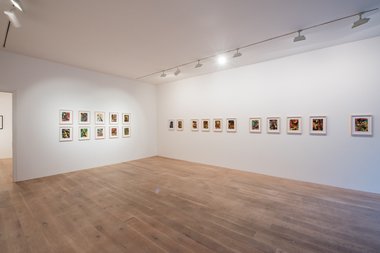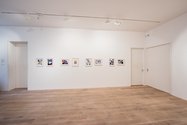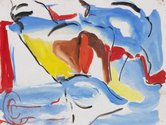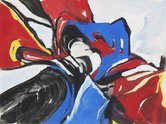John Hurrell – 25 August, 2018
The thirty year old gouaches are lean and cool, rich in blue, red or black, use fine brushes and have lots of pale grey airy space, while often alluding to landscape beach forms and flickering light. Last year's images in contrast have some airbrush or ‘flicked' spray, a hotter palette—with yellows, oranges, purples and browns—and lots of finger painting that with thick viscous paint mingles hues inside zigzagging and criss-crossing lines that seem to reference fingers and hand.
This is an interesting show about Judy Millar’s visual research: it examines compositional and chromatic possibilities within small sketches intended to be enlarged later and different techniques applied. These works on heavy paper are in two groups: gouaches from 1989, and oil on acrylics from last year. They are quite different in energy, chroma, method and density.
In fact, the latter selection can be split again. Overall I think there are really three groups. Three different moods. Three different mental and optical spaces.
The thirty year old gouaches are lean and cool, rich in blue, red or black (a ‘natural’ outdoors palette with clean thin colour), use fine brushes and have lots of pale grey airy space, while often alluding to landscape beach forms, the occasional body, and flickering light.
Last year’s images in contrast have some airbrush or ‘flicked’ spray, a hotter palette—with yellows, oranges, purples and browns—and lots of finger painting that with thick viscous paint mingles hues inside zigzagging and criss-crossing lines that seem to reference fingers and hand, or maybe tree forms
Within the 2017 group some are particularly dense, with not much splattered background peaking through. There is a compactness that references the AbEx tradition in a way that Millar’s larger ‘subtractive’ method works usually avoid: these have a different look. Packed with minute specks and splodges, they have a greater viscosity and less liquidity, with lots of turbulent underpainted marks visible underneath.
These works also have a compressed energy as if various forces are about to be released—but currently staying under tight control. The 1989 works in comparison seem somewhat flaccid and relaxed. Devoid of tension and more open, they provide an intriguing foil.
John Hurrell
















 Advertising in this column
Advertising in this column Two Rooms presents a program of residencies and projects
Two Rooms presents a program of residencies and projects



This Discussion has 0 comments.
Comment
Participate
Register to Participate.
Sign in
Sign in to an existing account.